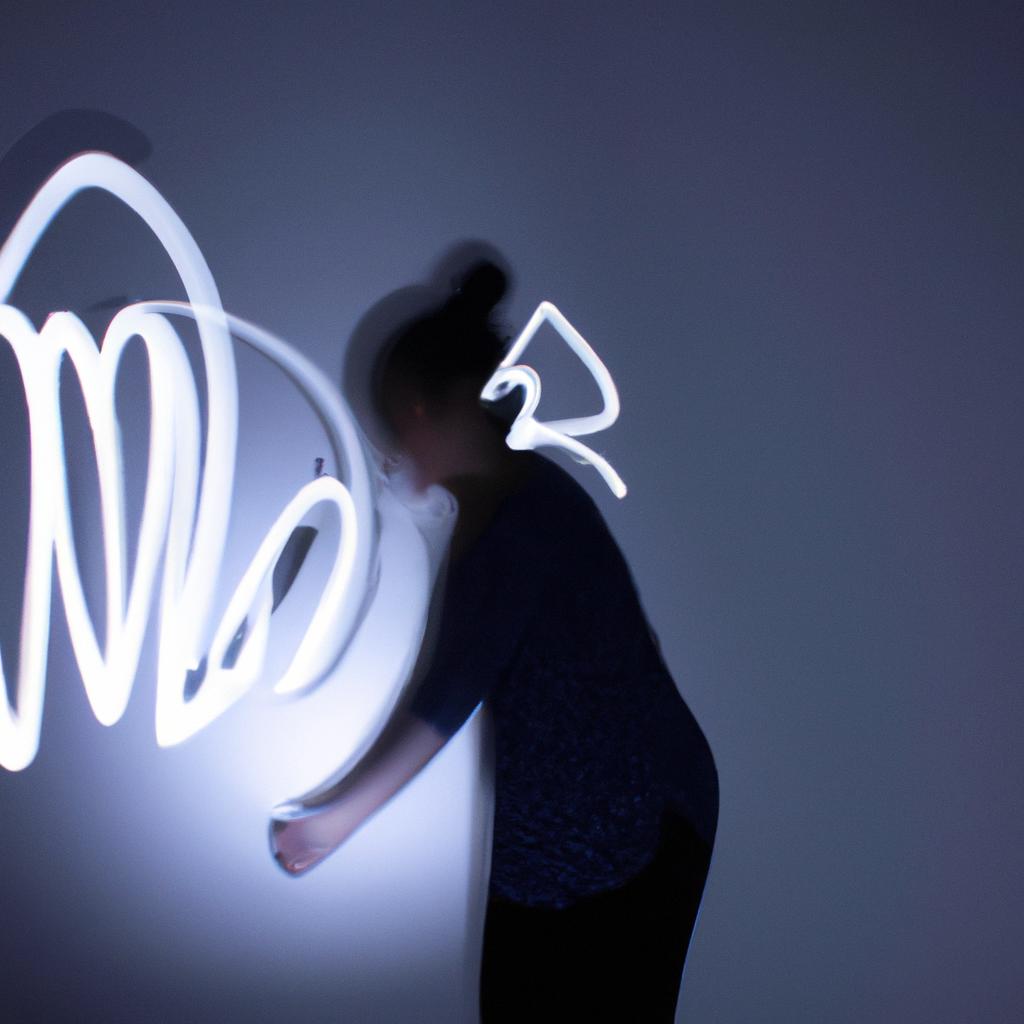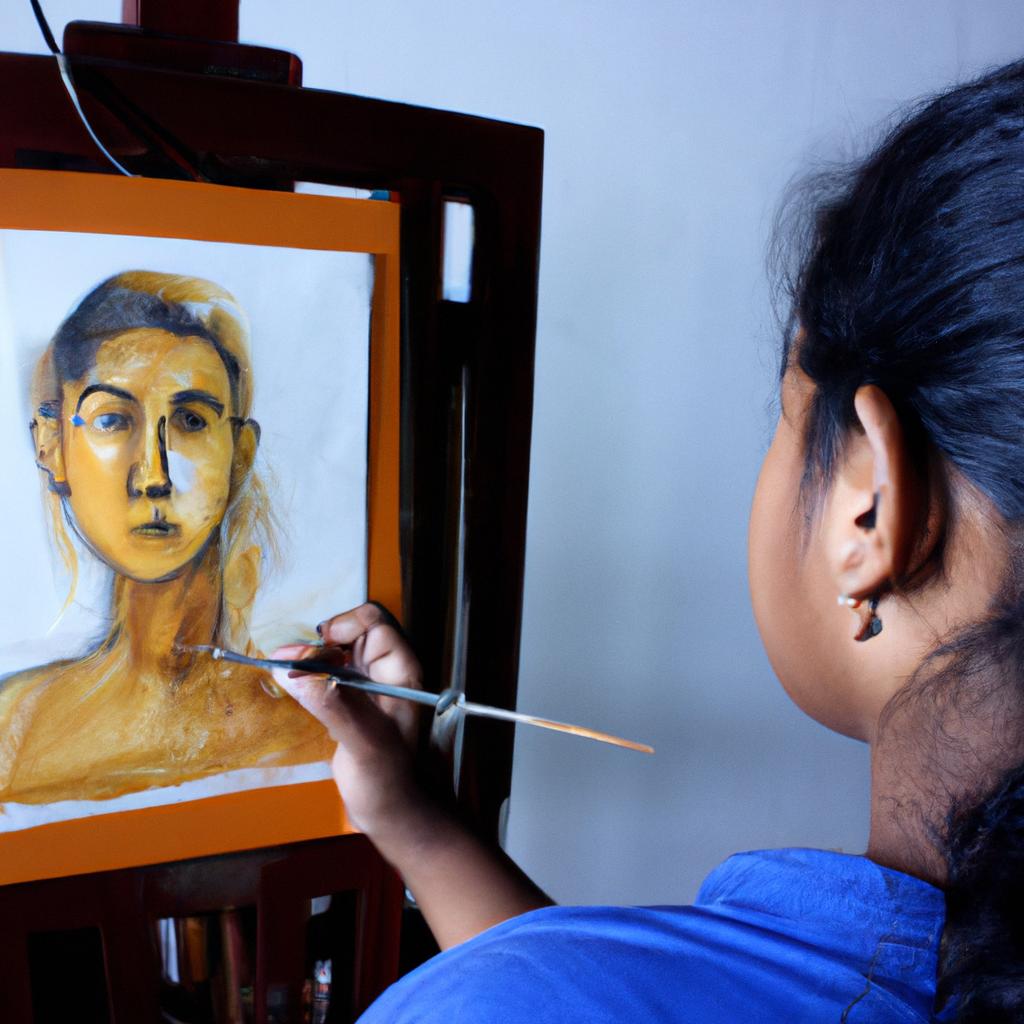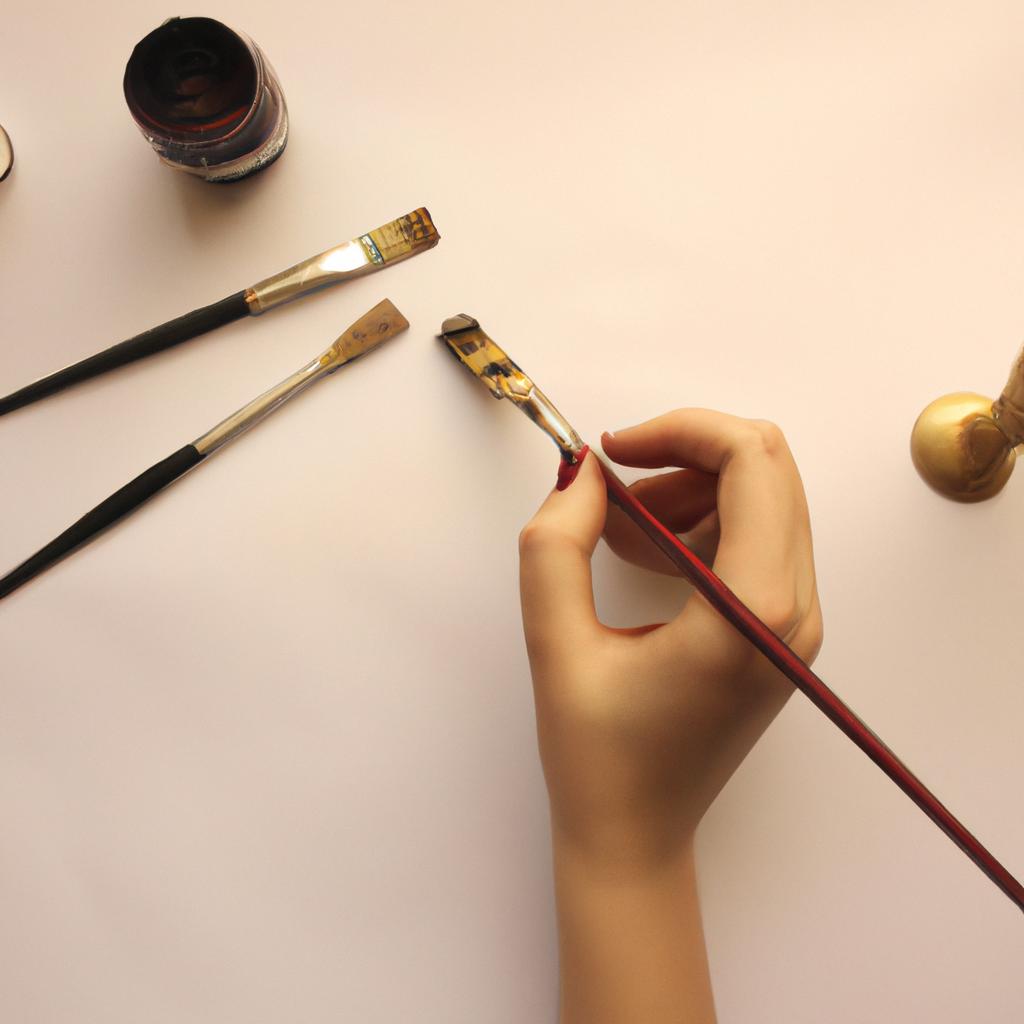Still life is a genre of art that has been practiced in both painting and photography, offering unique perspectives on the depiction of objects and their contexts within the realm of visual arts. The concept behind still life involves arranging and capturing inanimate subjects, such as fruits, flowers, or everyday objects, with meticulous attention to detail and composition. This article explores the artistry and significance of still life through an examination of its evolution across different artistic mediums, focusing particularly on the interplay between painting and photography.
To illustrate this relationship between painting and photography within the context of still life, consider the hypothetical case study of two artists: one specializing in traditional oil paintings while the other employs digital photography techniques. Both artists are tasked with capturing a bouquet of vibrant flowers against a neutral background. Through their distinct approaches, they bring forth converging yet diverging interpretations of reality. While the painter meticulously applies brushstrokes to create texture, depth, and luminosity on canvas, the photographer expertly selects angles, lighting conditions, and post-production editing methods to accentuate colors and emphasize details captured by the camera lens. Despite these differences in technique and medium utilized, both artists strive to portray beauty in stillness – encapsulating not only the physical attributes but also evoking emotions associated with the subjects.
In painting, still life has a long history dating back to ancient times, where it was often used as a way to showcase wealth and status. The careful arrangement of objects allowed artists to demonstrate their technical skills in rendering textures, light, and shadow. Over time, still life evolved into a genre that explored deeper meanings and symbolism. Artists began to use objects as metaphors for human experiences or societal issues. For example, a wilting flower may symbolize the transience of life or the passing of time.
Photography, on the other hand, introduced new possibilities for capturing still life. With advancements in technology, photographers could freeze moments in time with precision and accuracy. This led to an increased focus on capturing details and creating hyper-realistic representations of objects. Photographers also experiment with lighting techniques and compositional elements to create visually striking images.
While painting allows for more subjective interpretations through brushwork and manipulation of colors, photography offers a sense of immediacy and objectivity due to its ability to capture reality as it is perceived by the camera lens. However, both mediums allow for creative expression and convey emotions through their unique approaches.
In conclusion, still life remains an enduring genre that continues to be explored by artists in various mediums. Whether through painting or photography, artists strive to depict the beauty and significance found within ordinary objects. The interplay between these two mediums not only showcases different artistic techniques but also highlights how both can evoke emotions and provoke thoughts about our relationship with the world around us.
The Origins of Still Life Photography
In the world of art, still life has long been a popular subject matter. From paintings to sculptures, artists have explored the beauty and meaning behind everyday objects that are carefully arranged in a composition. With the advent of photography, this genre found its way into the realm of capturing moments frozen in time. The origins of still life photography can be traced back to the early days of the medium when pioneers like William Henry Fox Talbot and Louis Daguerre began experimenting with new techniques.
One notable example is Anna Atkins, an English botanist and photographer who produced what is considered by many as the first book illustrated with photographic images. In her work “Photographs of British Algae: Cyanotype Impressions,” published in 1843, she used cyanotypes to document various types of seaweed. This groundbreaking achievement not only demonstrated the scientific applications of photography but also marked a significant milestone for still life photography as a means to capture intricate details and textures.
- Immersion in a sea of colors
- Appreciation for meticulous arrangement
- Reflection on transience and mortality
- Delightful discovery amidst ordinary objects
Furthermore, examining still life photography through a comparative lens helps shed light on its significance within different artistic contexts. The table below presents three key elements often seen in both traditional painting and contemporary photographic representations:
| Element | Traditional Painting | Contemporary Photography |
|---|---|---|
| Composition | Carefully arranged | Purposefully staged |
| Lighting | Controlled | Experimentation with natural light |
| Representation | Meticulous attention to detail | Emphasis on realism or abstraction |
This analysis reveals how photographers have built upon established techniques while pushing boundaries in terms of creativity and experimentation. By exploring these parallels between mediums, we gain insights into how still life photography has evolved as an art form in its own right.
Transitioning to the subsequent section on “The Evolution of Still Life Photography,” it becomes evident that this genre has continued to transform and adapt throughout history. The pioneers mentioned earlier laid the foundation, but subsequent generations of photographers have built upon their work, incorporating new technologies and artistic expressions while exploring a range of themes and concepts.
The Evolution of Still Life Photography
Transitioning from the exploration of the origins, we now delve into the fascinating evolution of still life photography. To illustrate this progression, let us consider a hypothetical case study of an aspiring photographer named Emily who embarked on her artistic journey in the early 20th century.
As Emily honed her skills, she experimented with various techniques and compositions to capture objects in unique ways. She embraced the concept that still life photography could transcend mere representation and become a means for self-expression. In doing so, she followed in the footsteps of artists before her who sought to convey their emotions through carefully arranged objects.
The evolution of still life photography can be characterized by several key factors:
- Technological advancements: With the advent of more advanced cameras and equipment, photographers like Emily were able to explore new possibilities in capturing light, texture, and depth. This allowed them to create images that emphasized contrast or played with shadows to evoke different moods.
- Cultural influences: As society changed over time, so did the subjects chosen for still life compositions. From traditional depictions of fruit bowls and flower arrangements, photographers began incorporating everyday items such as discarded objects or industrial materials. This shift reflected a desire to comment on societal changes and challenge conventional norms.
- Conceptual interpretations: Beyond representing physical objects, still life photography increasingly became a medium for conceptual exploration. Artists like Emily used symbolism and metaphor within their compositions to provoke thought and engage viewers emotionally.
- Artistic movements: Just as painting experienced shifts in style throughout history, so too did still life photography. Movements such as Surrealism and Cubism influenced photographers’ approaches by encouraging experimentation with perspective, composition, and juxtaposition.
To further emphasize these elements shaping the evolution of still life photography, we present below a bullet point list highlighting its emotional impact:
- Capturing fleeting beauty amidst decay
- Challenging perceptions through unconventional placements
- Provoking nostalgia and contemplation through familiar objects
- Inviting viewers to find beauty in the ordinary
In addition, we present a table that showcases different artistic movements and their influence on still life photography:
| Artistic Movement | Characteristics | Notable Artists |
|---|---|---|
| Surrealism | Dreamlike compositions | Man Ray, Salvador Dali |
| Cubism | Fragmented forms and multiple viewpoints | Pablo Picasso |
| Pop Art | Bold colors and popular culture references | Andy Warhol |
With Emily’s journey as our backdrop, we have witnessed how still life photography has evolved from its humble origins into a medium ripe with expressive potential. In the subsequent section on “Techniques and Composition in Still Life Photography,” we further explore the methods employed by photographers like Emily to capture captivating images that continue to captivate audiences today.
Techniques and Composition in Still Life Photography
The Evolution of Still Life Photography has provided us with an understanding of how this genre has developed over time. Now, let us delve into the techniques and composition that are employed in creating captivating still life photographs.
To illustrate the importance of technique and composition, consider the following example: a photographer aiming to capture a simple arrangement of fruits on a table. By carefully selecting the lighting, focal length, and camera angle, they are able to create a visually stunning image that draws viewers’ attention to the vibrant colors and textures of the fruit.
In still life photography, several key elements contribute to its overall impact:
- Lighting: The choice of lighting can dramatically affect the mood and atmosphere of a still life photograph. Soft diffused light tends to create a calm and serene ambiance, while harsher lighting may evoke tension or drama.
- Composition: Arranging objects within the frame is essential for creating balance and visual interest. Techniques such as rule of thirds, leading lines, and symmetry can be used to guide viewers’ eyes through the image.
- Color palette: Deliberate color choices play a crucial role in establishing the tone and emotional response elicited by a still life photograph. Harmonious or contrasting color schemes can convey different moods or highlight specific elements.
- Depth of field: Selective focus allows photographers to draw attention to particular subjects within their compositions while blurring out distracting backgrounds. This technique adds depth and dimensionality to the photograph.
These elements work together harmoniously in successful still life photography, enhancing both aesthetic appeal and storytelling potential. To further understand their significance, we can examine them more closely in the following table:
| Technique | Purpose | Example |
|---|---|---|
| Rule of Thirds | Creates balance by dividing an image into nine equal parts | Placing a key object along one of these imaginary lines |
| Leading Lines | Guides the viewer’s gaze through the photograph | Utilizing a road or path that leads from the foreground to the background |
| Symmetry | Provides a sense of order and harmony | Photographing two identical objects placed symmetrically |
| Color Contrast | Emphasizes specific elements and adds visual interest | Placing a red apple against a backdrop of predominantly green fruits |
In summary, still life photography relies on careful consideration of techniques and composition. By exploring lighting, composition, color palette, and depth of field, photographers can create visually captivating images that elicit emotional responses in viewers.
Transitioning into our subsequent section about “Symbolism and Meaning in Still Life Photography,” we will now explore how these technical aspects contribute to conveying deeper messages within this genre.
Symbolism and Meaning in Still Life Photography
Transitioning from the previous section, where we explored techniques and composition in still life photography, we now delve into the realm of symbolism and meaning within this art form. By imbuing everyday objects with deeper significance, photographers have the power to communicate profound messages through their images. To illustrate this concept, let us consider a hypothetical example.
Imagine a photograph featuring a wilted flower lying on a cracked porcelain plate amidst scattered ashes. This juxtaposition of fragility and destruction serves as a symbol for the transience of life and the inevitable decay that awaits all living beings. The photographer skillfully manipulates elements within the frame to evoke emotions and provoke contemplation.
Symbolism plays an essential role in still life photography by allowing artists to convey complex ideas or narratives without relying solely on explicit representation. Through careful selection and arrangement of objects, photographers can create visual metaphors that resonate with viewers on multiple levels. Here are some common symbols used in still life photography:
- Skulls or bones – representing mortality
- Hourglasses or clocks – signifying time’s passing
- Mirrors – reflecting self-reflection or introspection
- Candles – symbolizing illumination or enlightenment
To further explore the various symbols employed in still life photography, let us examine them more closely using a table format:
| Symbol | Meaning |
|---|---|
| Skulls | Mortality |
| Hourglasses | Time’s passing |
| Mirrors | Self-reflection or introspection |
| Candles | Illumination or enlightenment |
By employing these symbols strategically within their compositions, photographers engage viewers emotionally, prompting reflection upon universal themes such as life’s transitory nature and existential questions surrounding human existence.
As we conclude our exploration of symbolism and meaning in still life photography, it is important to note how contemporary artists continue to push boundaries within this genre. In the subsequent section, we will examine the incorporation of still life photography into contemporary art practices, exploring its evolution and influence in the modern artistic landscape.
Transitioning seamlessly into our next topic, let us now explore the realm of still life photography within the context of contemporary art.
Still Life Photography in Contemporary Art
In the previous section, we explored the symbolism and meaning behind still life photography. Now, let us delve into the contemporary art world’s perspective on this genre of photography. To illustrate this point, consider a hypothetical example where an artist captures a photograph of a simple bowl of fruit. At first glance, it may seem mundane, but upon closer inspection, one can discern layers of symbolic significance embedded within the composition.
Contemporary artists often employ various techniques to convey their intended message through still life photography. Here are some common strategies:
- Juxtaposition: By placing contrasting objects together in a single frame, photographers create visual tension that prompts viewers to question established norms or challenge societal conventions.
- Lighting: The skillful use of light and shadow adds depth and dimensionality to still life photographs. It enhances the mood and evokes emotions such as tranquility, solitude, or even melancholy.
- Composition: Artists meticulously arrange objects within the frame to create visually appealing patterns or narratives. This deliberate arrangement encourages viewers to interpret the artwork from different perspectives.
- Color palette: Specific color choices can evoke specific emotional responses in viewers. Vibrant hues may elicit feelings of joy or excitement, while muted tones might convey a sense of nostalgia or introspection.
To further explore these concepts, let us consider a table showcasing four notable still life photographs and their corresponding emotional impact:
| Photograph | Emotional Response |
|---|---|
| A wilted flower | Sadness |
| An overflowing fruit basket | Abundance |
| A solitary hourglass | Transience |
| A broken mirror | Fragmentation |
By utilizing diverse techniques like juxtaposition, lighting, composition, and color palette manipulation, contemporary photographers successfully capture powerful images that resonate emotionally with audiences.
As we move forward into our next section exploring the relationship between still life photography and other art forms, we will continue to uncover the intricate connections that exist within the realm of artistic expression. The interplay between still life photography and various art forms offers a rich tapestry for further exploration, revealing how these mediums inform and inspire one another.
Exploring the Relationship Between Still Life Photography and Other Art Forms
Building upon the significance of still life photography in contemporary art, it is crucial to investigate its dynamic relationship with other art forms. By exploring this interplay, a deeper understanding can be gained regarding how different artistic mediums influence and inspire one another.
One compelling example illustrating the connection between still life photography and other art forms is the collaboration between renowned photographer Laura Letinsky and painter Ann Hamilton. In their joint exhibition “Textures of Time,” Letinsky’s photographic compositions depicting carefully arranged objects were displayed alongside Hamilton’s large-scale paintings that incorporated similar motifs. This juxtaposition allowed viewers to observe how both artists explored themes of impermanence, transience, and decay through distinct yet complementary visual languages.
When examining various art forms in relation to still life photography, several key aspects come into focus:
- Composition: Just like painters meticulously arrange objects within a frame, photographers employ compositional techniques such as rule of thirds or leading lines to create visually captivating images.
- Lighting: Both painting and photography heavily rely on light manipulation to evoke mood and enhance details. Artists from both disciplines experiment with natural or artificial lighting sources to achieve their desired effect.
- Symbolism: Objects captured in still life photographs often carry symbolic meanings, just as they have done throughout art history. These symbols may be open-ended or culturally specific, inviting viewers to interpret their personal narratives.
- Conceptualization: While each medium has its own unique approach to conceptualizing artwork, still life photography shares common ground with painting when it comes to creating narrative scenes infused with symbolism and metaphorical layers.
To further illustrate these points, consider the following table showcasing the similarities between still life photography and painting:
| Aspect | Still Life Photography | Painting |
|---|---|---|
| Composition | Carefully arranged | Thoughtful positioning |
| placement of objects | and framing | |
| Lighting | Manipulation to | Skillful use of light |
| create mood and depth | and shadows | |
| Symbolism | Objects hold symbolic | Depiction of metaphorical |
| meanings | representations | |
| Conceptual- | Creation of narrative | Developing visual |
| ization | scenes with symbolism | narratives |
By exploring the interplay between still life photography and other art forms, it becomes evident that these mediums are not isolated entities but rather interconnected practices. Through their shared aspects such as composition, lighting techniques, symbolism, and conceptualization, they contribute to a broader artistic dialogue that enriches both individual works and the overall understanding of art itself.
Overall, this investigation highlights how still life photography can exist within a larger context of arts while engaging in a meaningful conversation with other creative disciplines. This exploration expands our appreciation for the diverse ways artists express themselves through different mediums, ultimately contributing to the richness and vitality of contemporary artistic practice.
 Balazo Gallery
Balazo Gallery



